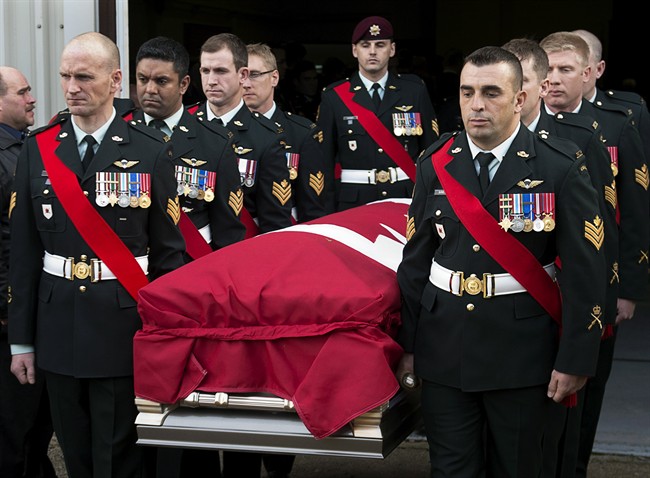TORONTO – Family doctors can play a key role in initially screening patients, such as those in the military, at high risk for post-traumatic stress disorder, an article in the Canadian Medical Association Journal suggests.

Author Dr. Allison Crawford, a psychiatrist at the Centre for Mental Health and Addiction, said patients who come to their general practitioner with complaints that include nightmares, insomnia and physical symptoms such as pain and fatigue may be suffering from post-traumatic stress disorder, or PTSD.
READ MORE: Veterans, advocacy groups say Canadian soldiers need mental health, transition support
“It’s underdiagnosed at the general practitioner level,” Crawford said in an interview Monday.
The article is timely, coming as it does after the recent apparent suicides of four members of Canada’s military. The deaths, which all occurred in the span of one week, have been linked to PTSD.
Crawford said families can also support a loved one who’s been through a psychologically disturbing event by keeping an eye out for symptoms – including mood swings, jumpiness and being withdrawn – and encourage them to seek medical help.
For physicians, a simple screening questionnaire can help determine if a patient – for instance, a member of the military previously deployed to Afghanistan – may have PTSD as a result of exposure to combat trauma.
READ MORE: For every suicide in the Canadian Forces, at least one attempt was recorded: documents
Many patients will not volunteer information about witnessing atrocities or other horrific experiences without being asked, said Crawford, who was a civilian psychiatrist at the Canadian Forces base in Kandahar in 2007.
The diagnosis of PTSD requires symptoms that last for more than one month and encompass at least three of the following areas:
- Having memories or nightmares of traumatic events
- Persistently avoiding thoughts, feelings, people or places that trigger memories of traumatic events
- Being constantly on guard, watchful or easily startled
- Feeling numb or detached from others, activities or surroundings
Crawford said up to 80 per cent of people will be exposed in their lifetime to events classified as traumatic, from being in a war zone or being a crime victim to losing their home in a flood or fire. But not everyone who experiences such emotionally devastating incidents develops PTSD.
“There are risks inherent in the trauma itself, so proximity to the trauma, how severe it is, whether their bodily integrity or physical safety was implicated. All of those things can make a person more likely to develop PTSD.”
WATCH: Justin Trudeau addresses need for helping soldiers with PTSD
“Some people are much closer to combat, for example. Some people have been there (in the combat area) longer. They are more likely to develop PTSD.”
Those who have pre-existing mental health conditions, particularly depression, anxiety or substance abuse, are also more prone to PTSD. That’s also true of people who have previously encountered trauma – childhood abuse or a violent assault, for instance.
“Women in particular, if they’ve been exposed to prior assaultive trauma – whether sexual or not – they are more likely to go on in subsequent traumas to develop PTSD, whether that subsequent trauma was assaultive or not,” said Crawford.
READ MORE: Veterans advocates issue warning over recent soldier suicides
In fact, women have twice the risk of PTSD than men, and when it comes to assaultive trauma, women are four to five times more likely to develop the disorder, she said.
Crawford said family doctors, general practitioners and nurse practitioners who have training in psychological interventions like cognitive behavioural therapy are usually equipped to treat people with PTSD. But in the absence of such training or when a case is more complex and difficult, patients can be referred to a psychiatrist or other mental health practitioner.
Treatment typically entails psychotherapy and anti-depressant medication. With psychological intervention only, about 60 per cent of patients show significant improvement. But for about 17 per cent who develop chronic PTSD, the symptoms can last for years, she said.
“So the risk of under-recognizing trauma and under-treatment of trauma is that more people may go on to have a chronic course, which is harder to treat.”



Comments